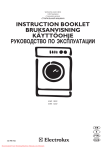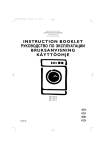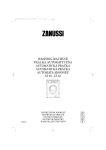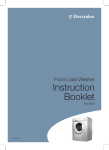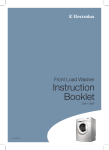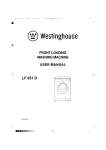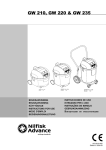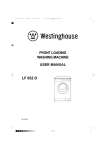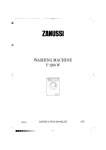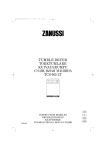Download Electrolux EWN 148641 W Operating instructions
Transcript
WASHING MACHINE TVÄTTMASKIN PYYKINPESUKONE STIRALWNAÅ MAfiINA INSTRUCTION BOOKLET BRUKSANVISNING KÄYTTÖOHJE RUKOVODSTVO PO ÈKSPLUATACII EWN 820 EWN 1020 GB S FIN 132 987 171 Downloaded From WashingMachine-Manual.com Manuals RUS Dear customer, Transport damages Please read these operating instructions carefully and pay particular attention to the safety notes indicated in the first pages. We recommend that you keep this instruction booklet for future reference and pass it on to any future owners. When unpacking the appliance, check that it is not damaged. If in doubt, do not use it and contact the Service Centre. Contents Warnings 3 Disposal 4 Tips for environmental protection 4 Technical specifications 4 Installation 5 Before loading the laundry 11 Maximum loads 11 Laundry weights 11 Removing stains 11-12 Detergents and additives International wash code symbols Operating sequence Programme Chart 12 13 14-16 17 Unpacking 5 Positioning 5 Water inlet 5 Door seal 18 Water drainage 6 Bodywork 18 Electrical connection 6 Detergent dispenser drawer 18 Maintenance Drain pump Your new washing machine Description of the appliance Detergent dispenser drawer 7 7 7 Use 18 18-19 Water inlet filter 19 Emergency emptying out 19 Frost precautions 19 Something not working? 20-21 8 Control panel 8 Controls 8-10 Washing hints 11 Sorting the laundry 11 Temperatures 11 The symbols you will see on some paragraphs of this booklet have the following meaning: The warning triangle and/or the key words (Warning!, Caution!) emphasize information that is particularly important for your safety or correct functioning of the appliance. The information marked with this symbol provides additional instructions and practical tips on the use of the appliance. Tips and information about economical and ecological use of the machine are marked with this symbol. Our contribution to the protection of the environment: we use recycled paper. 2 Downloaded From WashingMachine-Manual.com Manuals The following warnings are provided in the interests of overall safety. You must read them carefully before installing or using the appliance. • Leave the porthole door slightly ajar when the appliance is not in use. This preserves the door seal and prevents the formation of musty smells. Installation • All internal packing must be removed before using the appliance. Serious damage may be caused to the machine or adjacent furniture if the protective transit devices are not removed or are not completely removed. Refer to the relevant paragraph in the instruction book. • Always check that water has emptied out before opening the door. If not, drain the water following the instructions in the instruction book. • Always unplug the appliance and shut the water tap after use. • Any electrical work required to install this appliance must be carried out by a qualified electrician. General safety • Any plumbing work required to install this appliance must be carried out by a qualified plumber. • Repairs to the machine must be carried out only by qualified personnel. Repairs carried out by inexperienced persons could cause serious danger. Contact your local Service Centre. • After having installed the machine, check that it is not standing on its electrical supply cable. • Never pull the power supply cable to remove the plug from the socket; always take hold of the plug itself. • If the appliance is placed on a carpeted floor, ensure that air can circulate freely between the feet and the floor. • During high temperature wash programmes the door glass may get hot. Do not touch it! Use • This appliance is designed for domestic use. It must not be used for purposes other than those for which it was designed. Child safety • Children are often not aware of how dangerous electrical appliances can be. When the machine is working, children should be carefully supervised and not be allowed to play with the appliance. • Only wash fabrics which are designed to be machine washed. Follow the instructions on each garment label. • The packaging components (e.g. plastic film, polystyrene) can be dangerous to children danger of suffocation! Keep them out of children’s reach. • Do not overload the appliance. Follow the instructions in the instruction book. • Make sure that all pockets are empty. Objects such as coins, safety pins, pins and screws can cause extensive damage. • Keep all detergents in a safe place out of children’s reach. • Do not machine wash garments saturated with petroleum, methylated spirits, trichlorethylene, etc. If such fluids have been used to remove stains prior to washing, wait until they have completely evaporated from the fabric before placing garments in the appliance. • Make sure that children or pets do not climb into the drum. • When the appliance is to be scrapped, cut off the electrical supply cable and destroy the plug with the remaining cable. Disable the door catch in order to prevent children from becoming trapped inside while playing. • Place small items such as socks, belts, etc. in a cloth bag or pillowcase to prevent them getting trapped between the drum and the tub. • Use only the recommended quantities of fabric softener. An excessive amount could damage the laundry. 3 Downloaded From WashingMachine-Manual.com Manuals ENGLISH Warnings Disposal Packaging materials The materials marked with the symbol recyclable. The symbol on the product or on its packaging indicates that this product may not be treated as household waste. Instead it shall be handed over to the applicable collection point for the recycling of electrical and electronic equipment. By ensuring this product is disposed of correctly, you will help prevent potential negative consequences for the environment and human health, which could otherwise be caused by inappropriate waste handling of this product. For more detailed information about recycling of this product, please contact your local city office, your household waste disposal service or the shop where you purchased the product. are >PE<=polyethylene >PS<=polystyrene >PP<=polypropylene This means that they can be recycled by disposing of them properly in appropriate collection containers. Machine Use authorised disposal sites for your old appliance. Help to keep your country tidy! Tips for environmental protection To save water, energy and to help protect the environment, we recommend that you follow these tips: • With adequate pre-treatment, stains and limited soiling can be removed; the laundry can then be washed at a lower temperature, so saving energy. • Normally soiled laundry may be washed without prewashing in order to save detergent, water and time (the environment is protected too!). • Measure out detergent according to the water hardness, the degree of soiling and the quantity of laundry being washed. • The machine works more economically if it is fully loaded, but do not overload it. Technical specifications DIMENSIONS Height Width Depth 85 cm 60 cm 62 cm MAXIMUM LOAD Cotton Synthetics Delicates Woollens/hand wash 5.0 kg 2.5 kg 2.5 kg 2.0 kg SPIN SPEED 800 rpm max. (EWN 820) 1000 rpm max. (EWN 1020) POWER SUPPLY VOLTAGE/FREQUENCY TOTAL POWER ABSORBED MINIMUM FUSE PROTECTION 220-230 V/50 Hz 2200 W 10 A WATER PRESSURE 0.05 MPa 0.8 MPa Minimum Maximum This appliance complies with the following EEC Directives: 73/23/EEC of 19/02/73 relating to low voltage 89/336/EEC of 03/05/89 relating to electromagnetic compatibility. 4 Downloaded From WashingMachine-Manual.com Manuals Unpacking 5. Set the machine upright and remove the remaining rear screw. Slide out the relevant pin. All transit bolts and packing must be removed before using the appliance. 6. Plug all the holes with the plugs which you will find in the envelope containing the instruction booklet. You are advised to keep all transit devices so that they can be refitted if the machine ever has to be transported again. 1. Using a spanner, unscrew and remove the two rear bottom screws. Slide out the two plastic pins. Lay the machine on its back, taking care not to squash the hoses. This can be avoided by placing one of the corner packing pieces between the machine and the floor. P1128 P0002 Positioning Install the machine on a flat hard floor. Make sure that air circulation around the machine is not impeded by carpets, rugs etc. Check that the machine does not touch the wall or other kitchen units. Carefully level by screwing the adjustable feet in or out. Never place cardboard, wood or similar materials under the machine to compensate for any unevenness in the floor. P0001 P1129 2. Remove the polystyrene block from the bottom of the machine and release the two plastic bags. 3. Very carefully slide out the left polythene bag, removing it towards the right and then downwards. 1 2 3 P1124 P1051 Water inlet P1126 Connect the water inlet hose to a tap with a 3/4" thread. Do not use already employed hoses. 4. Very carefully slide out the right polythene bag, removing it towards the left and then upwards. The other end of the inlet hose which connects to the machine can be turned in any direction. Simply loosen the fitting, rotate the hose and retighten the fitting, making sure there are no water leaks. P1127 P1088 5 Downloaded From WashingMachine-Manual.com Manuals P0021 ENGLISH Installation Electrical connection The inlet hose must not be lengthened. If it is too short and you do not wish to move the tap, you will have to purchase a new, longer hose specially designed for this type of use. This machine is designed to operate on a 220-230 V, single-phase, 50 Hz supply. Check that your domestic electrical installation can take the maximum load required (2.2 kW), also taking into account any other appliances in use. Water drainage Connect the machine to an earthed socket. The end of the drain hose can be positioned in three ways: The manufacturer declines any responsibility for damage or injury through failure to comply with the above safety precaution. Should the appliance power supply cable need to be replaced, this must be carried out by our Service Centre. Hooked over the edge of a sink using the plastic hose guide supplied with the machine. In this case, make sure the end cannot come unhooked when the machine is emptying. This could be done by tying it to the tap with a piece of string or attaching it to the wall. The power supply cable must be easily accessible after installing the appliance. P0022 In a sink drain pipe branch. This branch must be above the trap so that the bend is at least 60 cm above the ground. Directly into a drain pipe at a height of not less than 60 cm and not more than 90 cm. The end of the drain hose must always be ventilated, i.e. the inside diameter of the drain pipe must be larger than the outside diameter of the drain hose. The drain hose must not be kinked. Run it along the floor; only the part near the drainage point must be raised. P0023 6 Downloaded From WashingMachine-Manual.com Manuals This new washing machine meets all modern needs for effective treatment of laundry with low water, energy and detergent consumption. • The possibility of selecting the temperature, spin speed and all the options offered by this washing machine gives you truly “customised” washing. • The programme progress display shows the programme steps selected and the programme phase which is running. • The special wool programme with its new delicate wash system treats your woollens with extreme care. • The balance control device ensures the machine is stable during the spin. • Automatic cooling of the wash water to 60°C before draining, with the 95°C programme. This reduces thermal shock to fabrics, helping to prevent creasing. Description of the appliance 1 Detergent dispenser drawer 1 2 2 Control panel 3 Door handle 4 Drain filter 95°C 60°C 40°C 30°C 800 700 600 500 / EWN 820 5 Adjustable feet 3 4 5 Detergent dispenser drawer Prewash Main wash Fabric softener, starch C0063 7 Downloaded From WashingMachine-Manual.com Manuals ENGLISH Your new washing machine Use Control panel 1 2 3 95°C 60°C 40°C 30°C 800 700 600 500 4 5 / 7 6 8 9 10 By selecting position the machine will wash with cold water. To be used for extremely delicate items, such as curtains. 1 ON/OFF button Press this button to switch the washing machine on. Press the ON/OFF button again to switch the machine off. Important! By depressing TEMPERATURE and SPIN SPEED buttons simultaneously, the acoustic signal is switched off in the following cases: 2 MAINS-ON light • when depressing the buttons This light is connected to the ON/OFF button . It lights up when you press the button, and goes out when you press it again. • when an incorrect option selection is made • at the end of the programme. 3 FABRIC button 5 SPIN SPEED button Press this button repeatedly to select the programme on the basis of the type of laundry to be washed. The light relevant to the selected programme will light up. The washing machine will propose a temperature and automatically select the maximum spin value provided for the programme you have chosen. You can change these values by operating buttons 4 and 5. Press this button repeatedly to change the spin speed, if you want your laundry to be spun at a speed different from the one proposed by the washing machine. The relevant light will light up. Maximum speeds are: EWN 820 Hand wash When you select this programme, you obtain a particularly delicate washing, suitable for articles of clothing whose label indicates that they must be hand-washed . • for cottons, synthetics, wool and handwash: fo 800 rpm; • for delicate fabrics: 700 rpm. EWN 1020 • for cottons::1000 rpm; 4 TEMPERATURE button • for synthetics, wool and handwash: 900 rpm; Press this button repeatedly to increase or decrease the temperature, if you want your laundry to be washed at a temperature different from the one proposed by the washing machine. The relevant light will light up. Maximum temperatures are 95°C for cotton, 60°C for synthetic fabrics, 40°C for delicate fabrics, wool and fabrics to be handwashed. • for delicate fabrics: 700 rpm. 8 Downloaded From WashingMachine-Manual.com Manuals This button has two functions: • Start: after you have selected the desired programme and options, press this button to start the washing machine. The light above the button will stop flashing and remain lit. At the end of the cycle the door is locked, the light of the START/PAUSE button goes off, the pilot lights and remain lit, to indicate that the water must be drained. To complete the cycle, choose one of the following options: • Pause: when you press this button again, the programme in progress is interrupted. The light above the button will start flashing. To restart the programme, press the button again. • Drain : Press the SKIP/RESET button once, all the leds are off, then press button in order to select the desired programme. If you wish to drain or to spin press SKIP/RESET button until the led of the desired function remains lit. You can change the spin speed by means of button and then depress START/PAUSE button. Important! You must set the washing machine to PAUSE before you make any change in the programme in progress. 9 SKIP/RESET button At the end of a programme, you must press this button once or repeatedly, in order to clear the contents of the memory; otherwise, the next time you switch the washing machine on, the pilot lights relevant to the end of the previous cycle will go on. Important! If you accidentally press the RESET button more than once, the programme is cancelled. To cause the washing machine to drain the water, select any washing programme by means of the FABRIC button , then press RESET three times in order to select the DRAIN position (only the DRAIN light will light up). You can also press the RESET button to exclude one or several phases of the programme which is running, as indicated below. - set the washing machine to PAUSE by pressing the START/PAUSE button (the relevant light will flash); 6-7 OPTIONS buttons Press these buttons to select the following options: - press the RESET button once or several times, until the required phase(s) is(are) cancelled (the light next to the symbol of the phase(s) will go out). • PREWASH : select this option if you wish your laundry to be prewashed before the main wash (not available for wool and handwash). The prewash ends with a short spin at 650 rpm in programmes for cotton and synthetic fabrics, whereas in the programme for delicate fabrics the water is only drained. Example: / • QUICK WASH : for laundry that is only slightly soiled (not for wool and HAND WASH programme). The washing time will be reduced according to the type of fabric and the selected temperature. The PREWASH and QUICK WASH options cannot be selected together. • ECONOMY : this option can be selected only for cottons and synthetics lightly or normally soiled with a temperature 40°C or higher. The washing time will be prolonged and the washing temperature will be reduced. This button allows you also to select special programmes, such as RINSES, SPIN and DRAIN. • If the machine is already switched on because it has just performed a washing programme, proceed as follows: 9 Downloaded From WashingMachine-Manual.com Manuals In this case, the spin (at the speed provided for the selected type of fabric) will be performed. ENGLISH 8 START/PAUSE button RINSE HOLD position : when you choose this option, the machine will not drain the water of the last rinse, so as not to wrinkle the laundry. - depress RESET once or repeatedly to cancel the previously performed programme (all the phase indicator lights must be off); 10 Programme phase indicator lights When you select a programme, the lights relevant to the phases that form the programme light up. - select the type of fabric by means of the relevant button; - select the special programme: • RINSES PREWASH/ WASH AND SPIN / RINSES Depress RESET once, the pilot light (PREWASH/WASH) goes out. SPIN / DRAIN END • SPIN Depress RESET twice, the pilot lights / (PREWASH/WASH) and RINSES go out. After you have started the programme, only the light relevant to the phase that is currently being carried out will remain lit. •DRAIN Depress RESET three times, the pilot lights / (PREWASH/WASH), RINSES and SPIN go out and goes on. At the end of the programme the pilot light illuminates. Example: The END light problems: / flashes in the event of operating 1 flash = the machine does not fill In this case the machine will perform the rinses and spin. 2 flashes = the machine does not empty 4 flashes = the door has not been closed To eliminate the problem, see paragraph “Something not working”. • If the machine is switched off: - depress ON/OFF button to switch it on; - select the type of fabric by means of the relevant button: - select the special programme as previously described. 10 Downloaded From WashingMachine-Manual.com Manuals ENGLISH Maximum loads Washing hints Recommended loads are indicated in the programme charts. Sorting the laundry General rules: Follow the wash code symbols on each garment label and the manufacturer’s washing instructions. Sort the laundry as follows: whites, coloureds, synthetics, delicates, woollens. Cotton, linen: drum full but not too tightly packed; Temperatures Washing a maximum load makes the most efficient use of water and energy. 95° for normally soiled white cottons and linen (e.g. tea cloths, towels, tablecloths, sheets...) For heavily soiled laundry, reduce the load size. 60° for normally soiled, colour fast garments (e.g. shirts, night dresses, pyjamas....) in linen, cotton or synthetic fibres and for lightly soiled white cotton (e.g. underwear). Laundry weights Synthetics: drum no more than half full; Delicate fabrics and woollens: drum no more than one third full. The following weights are indicative: bathrobe (cold) for delicate items (e.g. net curtains), mixed 30°-40° laundry including synthetic fibres and woollens. The wool wash cycle of this machine has been approved by Woolmark for the washing of machine washable Woolmark products provided that the garments are washed according to the instructions on the garment label and those issued by the manufacturer of this washing machine. Licence No. M9604. 1200 g napkin 100 g quilt cover 700 g sheet 500 g pillow case 200 g tablecloth 250 g towelling towel 200 g tea cloth 100 g night dress 200 g ladies’ briefs 100 g man’s work shirt 600 g man’s shirt 200 g Before loading the laundry man’s pyjamas 500 g Never wash whites and coloureds together. Whites may lose their “whiteness” in the wash. blouse 100 g men’s underpants 100 g New coloured items may run in the first wash; they should therefore be washed separately the first time. Removing stains Make sure that no metal objects are left in the laundry (e.g. hair clips, safety pins, pins). Button up pillowcases, close zip fasteners, hooks and poppers. Tie any belts or long tapes. Stubborn stains may not be removed by just water and detergent. It is therefore advisable to treat them prior to washing. Remove persistent stains before washing. Rub particularly soiled areas with a special detergent or detergent paste. Blood: treat fresh stains with cold water. For dried stains, soak overnight in water with a special detergent then rub in the soap and water. Treat curtains with special care. Remove hooks or tie them up in a bag or net. Oil based paint: moisten with benzine stain remover, lay the garment on a soft cloth and dab the stain; treat several times. Dried grease stains: moisten with turpentine, lay the garment on a soft surface and dab the stain with the fingertips and a cotton cloth. 11 Downloaded From WashingMachine-Manual.com Manuals Rust: oxalic acid dissolved in hot water or a rust removing product used cold. Be careful with rust stains which are not recent since the cellulose structure will already have been damaged and the fabric tends to hole. The detergent and any additives must be placed in the appropriate compartments of the dispenser drawer before starting the wash programme. Mould stains: treat with bleach, rinse well (whites and fast coloureds only). Pour liquid detergent into the dispenser drawer compartment marked just before starting the programme. If using concentrated powder or liquid detergents, a programme without prewash must be selected. Grass: soap lightly and treat with bleach (whites and fast coloureds only). Any fabric softener or starching additives must be poured into the compartment marked before starting the wash programme. Ball point pen and glue: moisten with acetone (*), lay the garment on a soft cloth and dab the stain. Lipstick: moisten with acetone as above, then treat stains with methylated spirits. Remove any residual marks from white fabrics with bleach. Follow the product manufacturer’s recommendations on quantities to use and do not exceed the «MAX» mark in the detergent dispenser drawer. Red wine: soak in water and detergent, rinse and treat with acetic or citric acid, then rinse. Treat any residual marks with bleach. Quantity of detergent to be used Ink: depending on the type of ink, moisten the fabric first with acetone (*), then with acetic acid; treat any residual marks on white fabrics with bleach and then rinse thoroughly. The type and quantity of detergent will depend on the type of fabric, load size, degree of soiling and hardness of the water used. Water hardness is classified in so-called “degrees” of hardness. Information on hardness of the water in your area can be obtained from the relevant water supply company, or from your local authority. Tar stains: first treat with stain remover, methylated spirits or benzine, then rub with detergent paste. (*) do not use acetone on artificial silk. Follow the product manufacturers’ instructions on quantities to use. Detergents and additives Use less detergent if: Good washing results also depend on the choice of detergent and use of the correct quantities to avoid waste and protect the environment. Although biodegradable, detergents contain substances which, in large quantities, can upset the delicate balance of nature. – you are washing a small load, – the laundry is lightly soiled, – large amounts of foam form during washing. The choice of detergent will depend on the type of fabric (delicates, woollens, cottons, etc.), the colour, washing temperature and degree of soiling. All commonly available washing machine detergents may be used in this appliance: – powder detergents for all types of fabric, – powder detergents for delicate fabrics (60°C max) and woollens, – liquid detergents, preferably for low temperature wash programmes (60°C max) for all types of fabric, or special for woollens only. 12 Downloaded From WashingMachine-Manual.com Manuals These symbols appear on fabric labels, in order to help you choose the best way to treat your laundry. Energetic wash 95 60 40 30 Max. wash temperature 95°C Max. wash temperature 60°C Max. wash temperature 40°C Max. wash temperature 30°C Delicate wash 60 Bleaching Bleach in cold water 40 Hand wash 30 40 Do not wash at all Do not bleach Ironing Hot iron max 200°C Warm iron max 150°C Lukewarm iron max 110°C Do not iron Dry cleaning Dry cleaning in all solvents Dry cleaning in perchlorethylene, petrol, pure alcohol, R 111 & R 113 Dry cleaning in petrol, pure alcohol and R 113 Do not dry clean high temperature low temperature Drying Flat On the line On clothes hanger 13 Downloaded From WashingMachine-Manual.com Manuals Tumble dry Do not tumble dry ENGLISH International wash code symbols 4. Switch the machine on Operating sequence To switch the machine on, press the ON/OFF button : the mains-on light comes on. Before washing your first load of laundry, we recommend that you run a cotton cycle at 95°C, with the machine empty, in order to remove any manufacturing residue from the drum and tub. Pour half a measure of detergent into the main wash compartment and start up the machine. 1. Place the laundry in the drum Open the door. Place the laundry in the drum, one item at a time, shaking them out as much as possible. 5. Select the desired programme/ fabric Press the FABRIC button repeatedly, in order to select the desired programme/fabric. The relevant light will light up. The lights relevant to the phases that form the programme will light up. The light of START/PAUSE button will start flashing. P1084 COTTONS SYNTHETICS 2. Measure out the detergent DELICATES / WOOL HANDWASH Pull out the dispenser drawer until it stops. Measure out the amount of detergent recommended by the manufacturer in a graduated cup and pour it into the main wash compartment . If you wish to carry out the prewash, pour detergent into the appropriate compartment marked . 6. Select the temperature Press the TEMPERATURE button if you wish to select a temperature value different from the one proposed by the washing machine. The relevant light will light up. 3. Measure out the additives If required, pour fabric softener into the compartment marked without exceeding the «MAX» mark. 95°C 60°C 40°C 30°C C0064 C0065 14 Downloaded From WashingMachine-Manual.com Manuals 10. How to change a programme during its cycle or the Press the SPIN SPEED button repeatedly, in order to select the desired spin speed or the RINSE HOLD option . The relevant light will light up. If you select the RINSE HOLD option , the machine will stop at the end of the programme with the water still in the tub. EWN 820 Before you make any change, you must pause the washing machine by pressing the START/PAUSE button. It is possible to change any option before the programme carries it out. Changing the type of fabric or temperature is possible, obviously, only by resetting it. When you make a change in these two parameters, the washing machine will resume the cycle from the beginning. The washing water in the tub will not emptied out. EWN 1020 800 700 600 500 1000 900 700 500 If it is necessary to drain the water in order to change the programme in progress, proceed as follows: • PAUSE the machine by pressing the START/PAUSE button; • press the SKIP/RESET button repeatedly, until only the DRAIN light remains lit; 8. Select the desired options Depress the relevant button to select the required options. The relevant light illuminates. • press the START/PAUSE button again. When the water has been drained, you may select a new programme and press the START/PAUSE button to start it. 11. How to cancel a programme during its cycle To cancel a programme that is being carried out, first pause the washing machine by pressing the START/PAUSE button, then press the SKIP/RESET button repeatedly, until the phase indicator lights go out. 9. Start the programme Press the START/PAUSE button. The relevant light will stop flashing and only the light relevant to the phase that is in progress will remain lit. 12. How to open the door during a programme You can open the door, after having set the washing machine to PAUSE, provided the following conditions exist: • the washing machine is not in the heating phase; • the level of the water is not high; • the drum is not turning. If these requirements are met, when you pause the washing machine, the door can be opened. Should it not be possible to open the door, and should it be absolutely necessary to do so, switch the machine off by pressing the ON/OFF button. After approximately 3 minutes, you can open the door. 15 Downloaded From WashingMachine-Manual.com Manuals ENGLISH 7. Select the SPIN SPEED RINSE HOLD option Pay attention to the level and temperature of the water in the washing machine! When you close the door and press the ON/OFF button again, the washing machine will resume the programme from the point where it had been interrupted. 13. End of programme The machine stops automatically. If the RINSE HOLD has been selected, the porthole is blocked, the light of the START/PAUSE button goes off, the pilot lights and remain lit, to indicate that the water must be drained. When the programme has been completed, the pilot light will go on again. Press the SKIP/RESET button repeatedly to erase the programme that has just been carried out. If you omit to do this, the next time you switch the washing machine on, the pilot lights relevant to the end of the previous cycle will go on. Note: when you switch the machine on, if you must erase the previously performed programme, it is also sufficient to press the FABRIC button and select a new programme. Press the ON/OFF button to switch the machine off. The relevant light will go out. Remove the laundry from the washing machine. Check whether the drum is completely empty, by rotating it with your hand. The purpose of this is to prevent any items of laundry from remaining accidentally in the drum, where they might get damaged in a subsequent wash (e.g. by shrinking) or bleed colour into another load of laundry. We advise you to close the water supply tap and disconnect the plug from the socket. Leave the door ajar in order to air the washing machine. 16 Downloaded From WashingMachine-Manual.com Manuals Type of laundry and symbols on labels 60 Programme/ temperature 5 kg Cottons 60°-95°C 95 White cotton: e.g. sheets, tablecloths, household linen 60 Consumption* Max load 40 30 Coloured cotton: e.g. shirts,blouses, underwear, towels, household linen Cottons+ ** 5 kg 5 kg 40 30 Synthetic fabrics and blends: e.g. shirts,blouses, underwear 40 2.5 kg 30 Delicate fab- 2.5 kg rics: e.g. acrylic fabrics, viscose, polyester, synthetic blends 40 30 2 kg Wool 2 kg Main wash at 60°-95°C 3 rinses Long spin Main wash at Cottons 60°-40°-30° or 60°-40°-30°C cold wash or 3 rinses Long spin Cottons 60°C + 60 Description of Available options programme Main wash at 60° 3 rinses Long spin Main wash at Synthetics 60°-40°-30° or 60°-40°-30°C cold wash or 3 rinses Short spin Delicates 40°-30°C or Wool 40°-30°C or Hand wash 40°-30°C or Energy kWh Water litres Time min. 2.3 66 160 1.4 63 130 1.06 58 150 1.0 58 95 Main wash at 40°-30°C or cold wash 3 rinses Short spin 0.55 58 65 Main wash at 40°-30°C or cold wash 3 rinses Short spin 0.45 60 55 Main wash at 40°-30°C or cold wash 3 rinses Short spin 0.45 60 56 * The consumption data shown on this chart is to be considered purely indicative, as it may vary depending on the quantity and type of laundry, on the inlet water temperature and on the ambient temperature. It refers to the highest temperature for each wash programme. ** In compliance with EC directive 92/75 the consumption figures indicated on the Energy label refer to this programme at 60°C + . The wool wash cycle of this machine has been approved by Woolmark for the washing of machine washable Woolmark products provided that the garments are washed according to the instructions on the garment label and those issued by the manufacturer of this machine. Licence No. M9604. 17 Downloaded From WashingMachine-Manual.com Manuals ENGLISH Washing programmes Maintenance Detergent can also accumulate inside the drawer recess: clean it with an old toothbrush. Refit the drawer after cleaning. Door seal Check from time to time the door seal and eliminate eventual possible objects that could be trapped in the fold. P0038 P1050 n Drain filter Bodywork The drain filter collects threads and small objects inadvertently left in the laundry. Check regularly that the filter is clean. Clean the outside of the machine with warm water and a neutral, non-abrasive household detergent. Rinse with clean water and dry with a soft cloth. Important: do not use methylated spirits, solvents or similar products to clean the bodywork. Open the filter door by pulling it towards the right. Place a container under the filter to catch any spillage. Detergent dispenser drawer Release the emergency emptying hose, place it in the container, and remove its cap by unscrewing it. After a while, detergents and fabric softeners leave deposits in the drawer. Clean the drawer from time to time by rinsing it under a running tap. To remove the drawer from the machine, press the button in the rear left-hand corner. To facilitate cleaning, the top part of the additive compartment can be removed. P1062 P1085 When no more water comes out, unscrew the filter and remove it. C0066 C0067 P1061 P0040 Clean the filter under a running tap, then refit it, screwing it fully in. Put the cap back on the emergency emptying hose, place the latter back in its seat. Close the filter door. C0068 P1086 18 Downloaded From WashingMachine-Manual.com Manuals ENGLISH Water inlet filter If you notice that the machine is taking longer to fill, check that the filter in the water inlet hose is not blocked. Turn off the water tap. Unscrew the hose from the tap. Clean the filter with a stiff brush. Screw the hose back onto the tap. P1090 Emergency emptying out If the water is unable to drain, proceed as follows to empty out the machine: • pull out the plug from the power socket; • close the water tap; • if necessary, wait until the water has cooled down; • Place a bowl on the floor under the filter and place the end of the emergency emptying hose into the bowl. The water should drain by gravity into the bowl. When the bowl is full, screw the cap on again. Empty the bowl. Repeat the procedure until water stops flowing out. • Clean the filter if necessary. • At the end screw the filter again. The dangers of freezing If the machine is exposed to temperatures below 0°C, certain precautions should be taken. • Turn off the water tap. • Unscrew the inlet hose. • Place the end of the inlet hose and that of the emergency emptying hose in a bowl placed on the floor and let the water drain out. • Screw the water inlet hose back on and put the emergency emptying hose back in its place after having screwed the cap on again. When you intend to start the machine up again, make sure that the room temperature is above 0°C. 19 Downloaded From WashingMachine-Manual.com Manuals Something not working? Problems which you can resolve yourself. During machine operation it is possible that the END pilot light working: flashes to indicate that the machine is not 1 flash = the machine does not fill 2 flashes = the machine does not empty 4 flashes = the door has not been closed At the same time the buzzer sounds. Once the problem has been eliminated, press the START/PAUSE button to restart the programme. If after all checks, the problem persists, contact your local Service Centre. Problem Possible cause • The machine does not start up: • The door is not firmly closed. • The machine is not plugged in or there is no power at the socket. • The main fuse has blown. • The START/PAUSE button has not been depressed. • The machine does not fill: • • • • • The machine fills then empties immediately: • The end of the drain hose is too low. Refer to relevant paragraph in “water drainage” section. • The machine does not empty and/or does not spin: • The drain hose is squashed or kinked. • The RINSE HOLD option has been selected. • The drain filter is clogged. • There is water on the floor: • Too much detergent or unsuitable detergent (creates too much foam) has been used. • Check whether there are any leaks from one of the inlet hose fittings. It is not always easy to see this as the water runs down the hose; check to see if it is damp. • The drain hose is damaged. • The cover of the drain filter has not been correctly screwed in after cleaning. • The cap on the emergency emptying hose has not been replaced after cleaning the filter. • Unsatisfactory washing results: • Too little detergent or unsuitable detergent has been used. • Stubborn stains have not been treated prior to washing. • The correct temperature was not selected. • Excessive laundry load. 20 Downloaded From WashingMachine-Manual.com Manuals The water tap is closed. The inlet hose is squashed or kinked. The filter in the inlet hose is blocked. The door is not properly closed. Possible cause • The machine vibrates or is noisy: • The transit bolts and packing have not been removed. • The support feet have not been adjusted. • The laundry is not evenly distributed in the drum. • Maybe there is very little laundry in the drum. • The machine is in contact with the wall or furniture. • The door will not open: • The programme is still running, the drum is turning. • The door lock has not yet released. • The water level is above the bottom edge of the door. • The machine is heating the water. • Spinning starts late or the laundry is not spun enough: • The electronic unbalance detection device has cut in because the laundry is not evenly distributed in the drum. The laundry is redistributed by reverse rotation of the drum. This may happen several times before the unbalance disappears and normal spinning can resume. If, after 5 minutes, the laundry is still not evenly distributed in the drum, the machine will spin at a lower speed or will not spin. If at the end of the programme the laundry is not spun enough, redistribute the load manually and select the spin programme. • The machine makes an unusual noise • The machine is fitted with a type of motor which makes an unusual noise compared with other traditional motors. This new motor ensures a softer start and more even distribution of the laundry in the drum when spinning, as well as increased stability of the machine. • No water is visible in the drum • Machines based on modern technology operate very economically using very little water without affecting performance. If you are unable to identify or solve the problem, contact our service centre. Before telephoning, make a note of the model, serial number and purchase date of your machine: the Service Centre will require this information. Mod. .......... Prod. No. ........... Ser. No. ......... ..... ..... ..... d. No. Mo d. Pro P0042N 21 Downloaded From WashingMachine-Manual.com Manuals ..... . . No Ser . ..... .... ENGLISH Problem The Electrolux Group. The world’s No.1 choice. The Electrolux Group is the world’s largest producer of powered appliances for kitchen, cleaning and outdoor use. More than 55 million Electrolux Group products (such as refrigerators, cookers, vacuum cleaners, chain saws and lawn mowers) are sold each year to a value of approx.14 billion USD in more than 150 countries around the world. MADE IN EEC Downloaded From WashingMachine-Manual.com Manuals























